
Introduction
In this section, we share with you the voices of our Indigenous Community Media Youth Fellows. Cultural Survival’s Indigenous Community Media Youth Fellowship supports individuals and groups of youth ages 17–25 in their efforts to build their radio journalism and radio broadcasting skills through trainings, community radio visits and exchanges, radio production, and conference attendance. Since 2018, we have supported 33 Indigenous youth fellows in 10 countries.
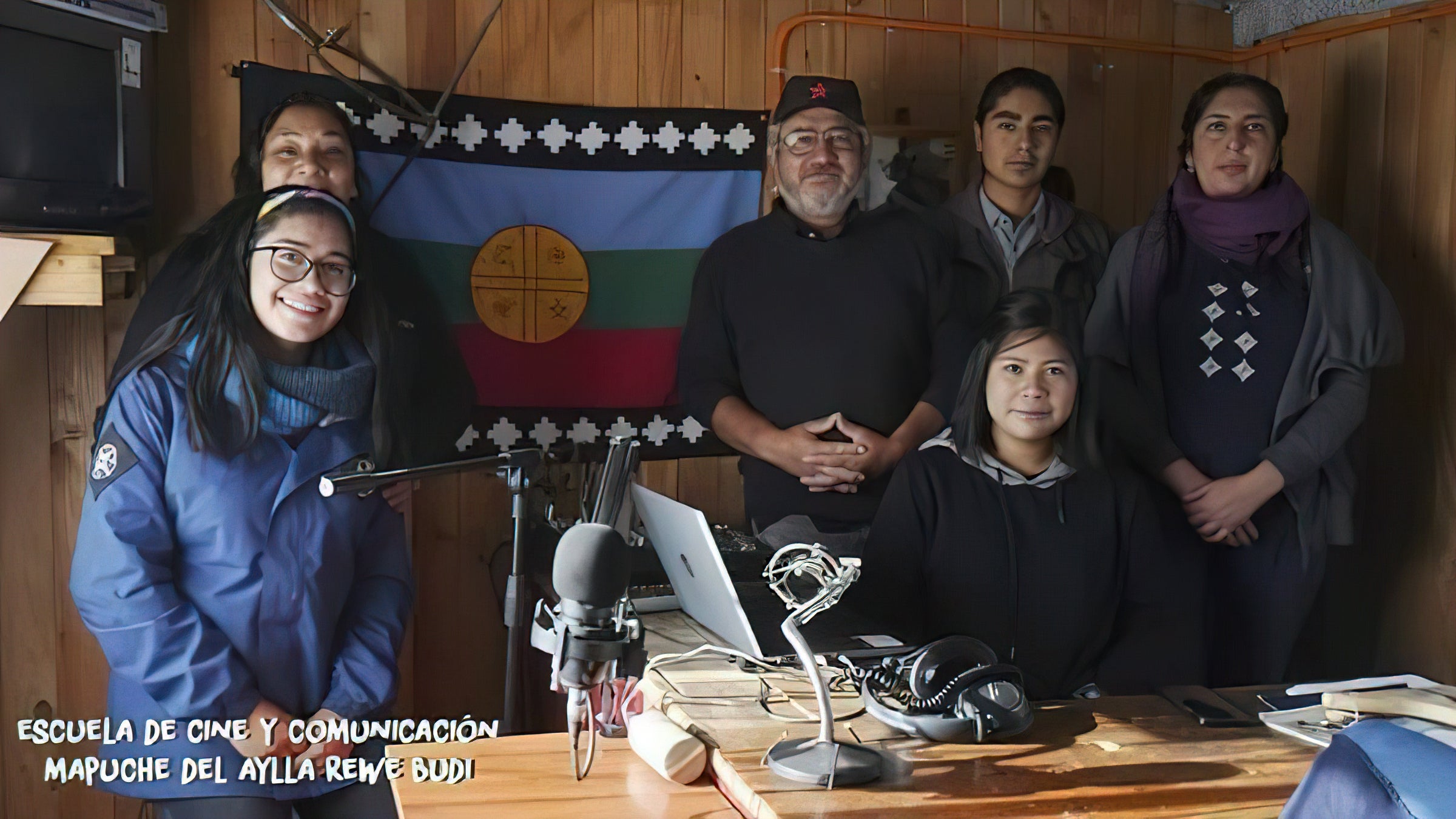
Photo: Team from the Mapuche Film and Communication School of Aylla Rewe Budi. Carolina Rain Ancan pictured in the blue coat, far left. Photo courtesy of Carolina Rain Ancan.
Representing Ourselves and Documenting the Knowledge of Our Elders
Carolina Trayen Rain Ancan (Mapuche), 18, is from the Lof Malalhue Chanko community in the Province of Cautin, Chile. She is part of the Mapuche School of Film and Communication of Aylla Rewe Budi, established by a group of youth to increase and strengthen communication from Mapuche Lafkenche perspectives. Since 2015, she has participated in many film productions and has received training in photography. Now in her last year of high school, she hopes to continue her studies in filmography. Her fellowship project, “Strengthening Mapuche Communication in the Budi Territory,” strengthened community media communication and Mapuche knowledge through audiovisual technology. She also created video and radio productions about Mapuche culture and language, using traditional stories and music.
We, the Mapuchelafkenche youth, are strengthening our communication from our own vision using the tools and technology as instruments for social and cultural investigation. We are taking into consideration Mapuche knowledge, participation, and validation from our traditional authorities; the families are the ones guiding this process. Since 2011, we, the youth of this Budi territory, have captured diverse subjects in film of the Mapuche medicine, ideological colonization, the identity of youth, territorial recovery, and many others.
We have the need to strengthen and revalidate the Mapuche knowledge of our territory by the teachings of our elders, who are the carriers of knowledge. This is a process developed by the Mapuche Film and Communication School of Aylla Rewe Budi, of which I am a member. Our ancestral territory is located between the Imperial River and the Toltén River, to which the Chilean State would correspond to the communities of Saavedra, Teodoro Schmidt, and Toltén.
It is in this territory that our way of life occurs and our identity is defined as Lafkenche del Budi Mapuche. [Our identity] is denied by the policies of the Chilean state. Therefore, there is the need to make visible our own forms of political and cultural organization as well as our own ways of relating and interacting with spaces and understanding life, and to revitalize our Mapudungun language. Capturing and documenting our knowledge using different tools and new technologies will allow us to give an important space for the Mapudungun and the oral testimony of our grandparents.
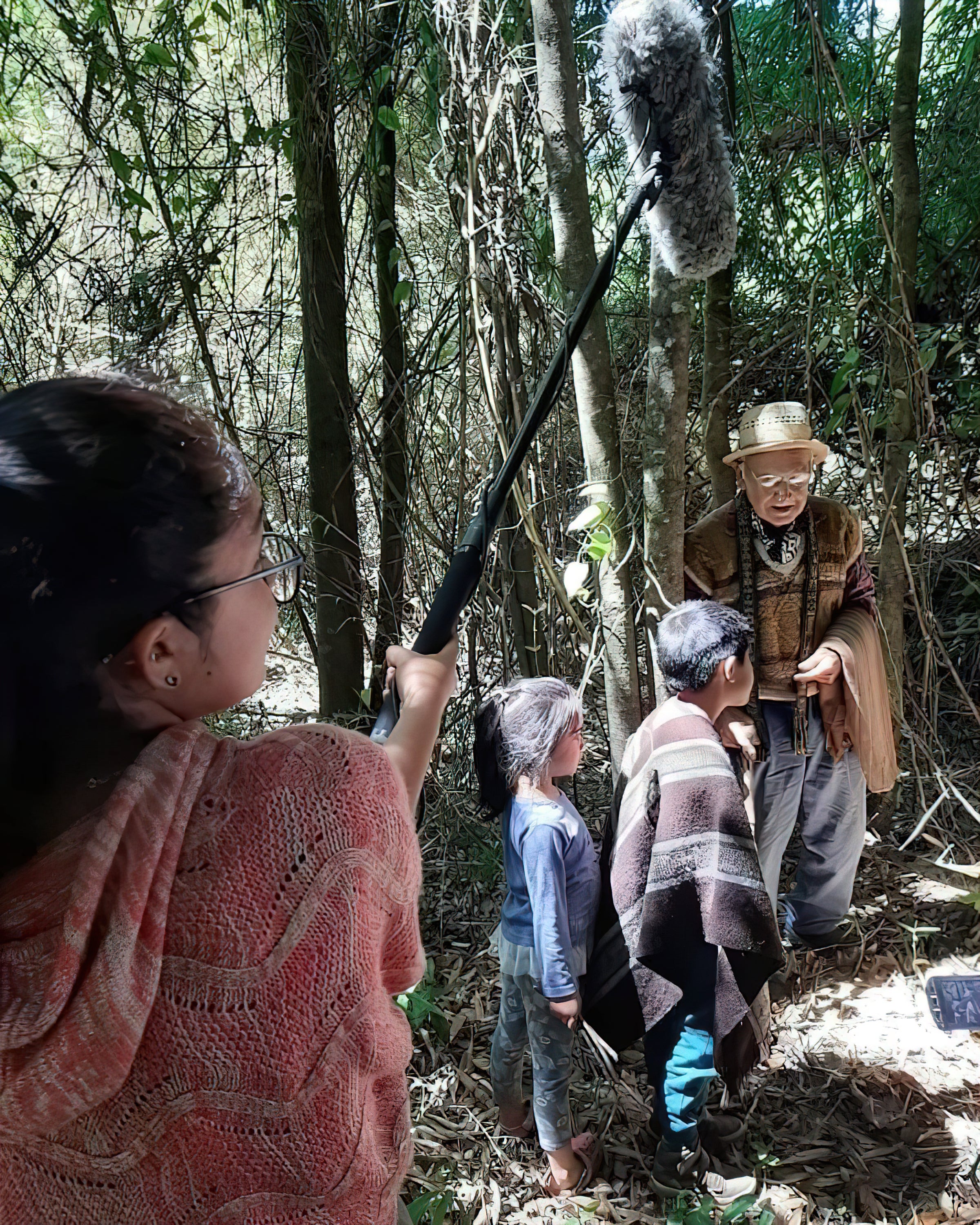
Photo: Carolina Rain Ancan (Mapuche) in the field filming Mapuche children learning from an elder. Photo courtesy of Carolina Rain Ancan.
The support of Cultural Survival has allowed me to strengthen my training and capacity in the creation of documentary short films. It has also allowed me to train in research processes from a Mapuche perspective, [which has enabled me to] transform the video documentary into a didactic tool capable of allowing us to define how we want to show ourselves and be represented through the image. With the support of the Aylla Rewe Budi Mapuche Film and Communication School, we can continue to strengthen Mapuche kimün (knowledge) of our territory and to strengthen the communication between generations to make sure this memory and knowledge of the territory lives on in oral stories.
Watch the Mapuche youth films at www.youtube.com/user/escuelacinemapuche.
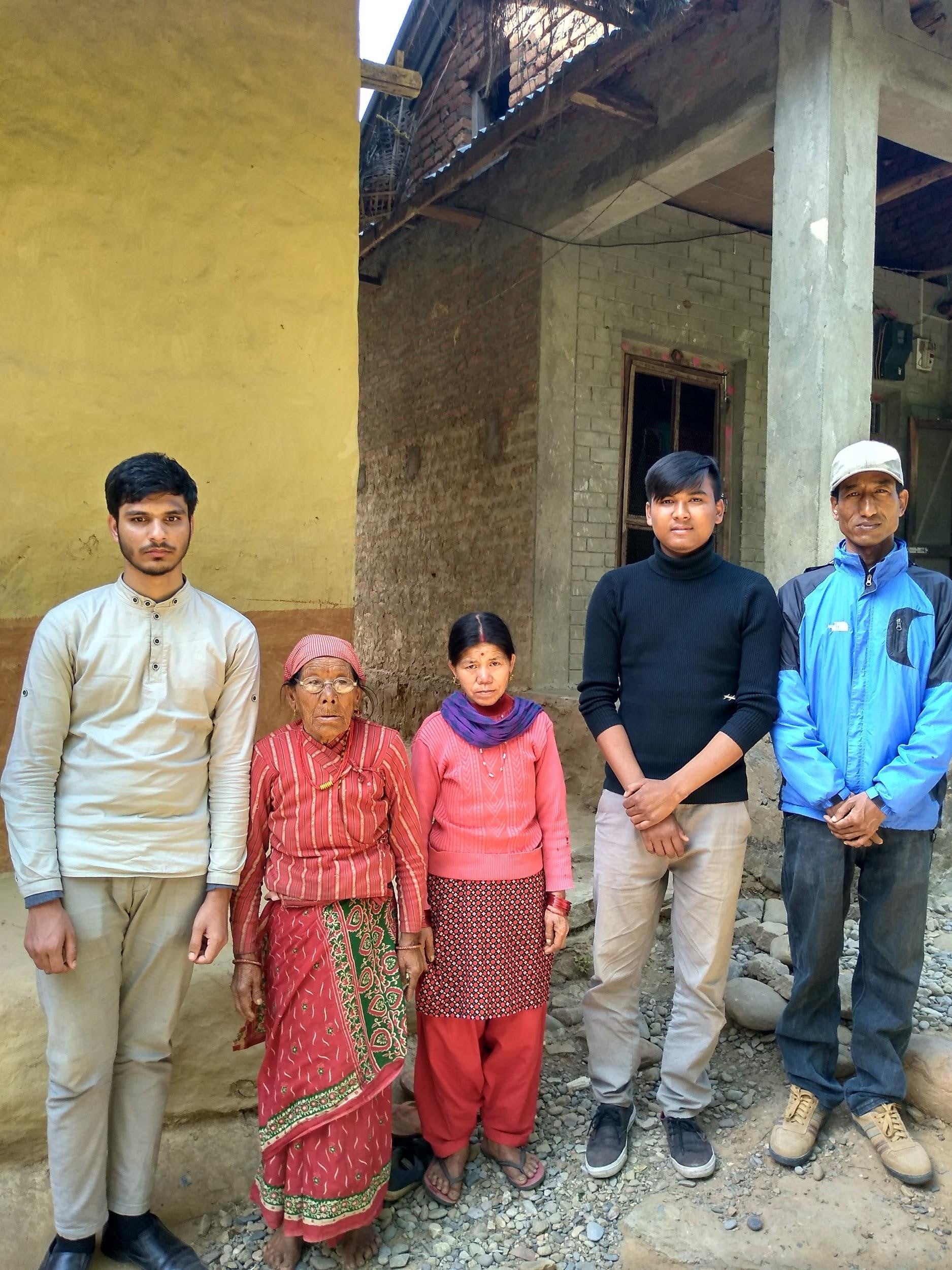
Photo: Visiting Kusunda community members. L-R: Uday Ale, Arnab Chaudhary, Gyani Maiya, and Nirajan
Sharma Adhikari. Photo courtesy of Arnab Chaudhary.
Racing Against Time to Save the Kusunda Language in Nepal
Arnab Chaudhary (Tharu), 21, hails from Gadhawa Village in the Dang district of Nepal. Currently in his third year of law school, he is fluent in Tharu, Nepali, Hindi, English, and Awadhi. As a fond reader of poetry and literature, he advocates for Indigenous languages in Nepal. He is also a legal intern for ProPublica working in the field of public interest litigation with a focus on environmental justice. Chaudhary previously worked as an executive member of the Kathmandu Valley Committee of the Tharu Student Society and continues to be active in discussions of social, legal, political, and economic issues related to Indigenous communities with his peers. In his youth fellowship project, “Vanishing Language of Kusunda Peoples,” he produced a radio program series about the Kusunda Peoples focused on promoting and strengthening their critically endangered language and culture. The program was broadcast on three local community radio stations where he invited members of the Kusunda community to participate in a live discussion on air.
To date, Chaudhary has produced three episodes for Radio Kusunda Aawaj. The latest episode highlights Kusunda culture and features interviews with Gyani Maiya Kusunda and Kamala Kusunda elders. At the time, Gyani Maiya Kusunda was one of two remaining fluent speakers of the Kusunda language. She passed away during the project term at the age of 81. Although plans to continue the project have been placed on hold temporarily, Chaudhary is creating material on the impacts of coronavirus in his community as there is a gap in communication between the state government and his people about the virus. He hopes to raise awareness about COVID-19 and COVID-19 prevention in Tharu. He shares with us his learnings about the Kusunda Peoples and their language.
Nepal, my home, is a beautiful biologically and culturally diverse country made up of mountains, hills, and plains. It is a nation of 125 caste groups and Tribes and 123 languages. All castes and Tribes have their own cultures, traditions, customs, and language. Among them are the Kusunda Peoples, an endangered minority, marginalized, nomadic Tribe with its own language. As an Indigenous Community Youth Media Fellow, I have worked as a journalist and raised the issue of the vanishing language of the endangered Indigenous Kusunda Tribe. I focused my radio program solely on the Kusunda people and their language because there is very little coverage about them [in the media], and lots of people don’t know about them to tell the world about their uniqueness.
In 2001, for the first time, the government of Nepal identified the Kusunda caste and listed it among Indigenous Tribes. According to that census, the total population of the Kusunda Tribe was 165 with 87 Kusunda language speakers. The 2011 census counted a population of 273 with 28 Kusunda language speakers. But according to researcher Uday Ale, their current population is only around 150, and with only 1 fully fluent speaker, Kamala Khatri. Khatri, 85, became the last fluent Kusunda speaker after the death of Gyani Maiya Kusunda on January 25, 2020.
The Kusunda people have been living in the central hills and the Terai of the western and midwestern regions of Nepal. Ale has also reported Kusunda people living in Tanahu, Gorkha, Arghakhanchi, Kapilvastu, Dang Deukhuri, Rolpa, Pyuthan and Surkhet districts of Nepal. My people are nomadic in nature and roam from one forest to another, but today no one lives in the forest. As hunters and gatherers, Kusunda ancestors used to live in huts and caves in the jungle and carry bows and arrows to hunt wild animals.
Generally, Kusunda people have a shorter physical appearance than the average Nepali. The term “Kusunda” is understood as a rude and insulting word in Nepal and they prefer to call themselves Myak, which means “king of the forest.” However, the word Kusunda has been accepted by Kusunda people. They also use the term to refer to tigers, since the tiger is also the king of the forest. A Kusunda man is called Banaraja (forest king), his wife is referred to as Banrani (forest queen), and daughters are Ban Maiya (forest princesses).
The Kusunda people are considered to be one of the most unique Indigenous Tribes of Nepal, and their language is also considered a unique language. It does not belong to any language family in the world and is not phonologically, morphologically, syntactically, or lexically related to any other languages; it is considered a language isolate. The Kusundas’ lifeways differ from other castes in terms of food, clothing, traditions, and livelihoods. Many Kusundas lack access to education and employment opportunities and are forced to live in poverty on Ailani (non-registered) government land. The Nepal Kusunda Development Society was formed in 2009 as an umbrella organization of the Kusunda people to advocate for their rights.
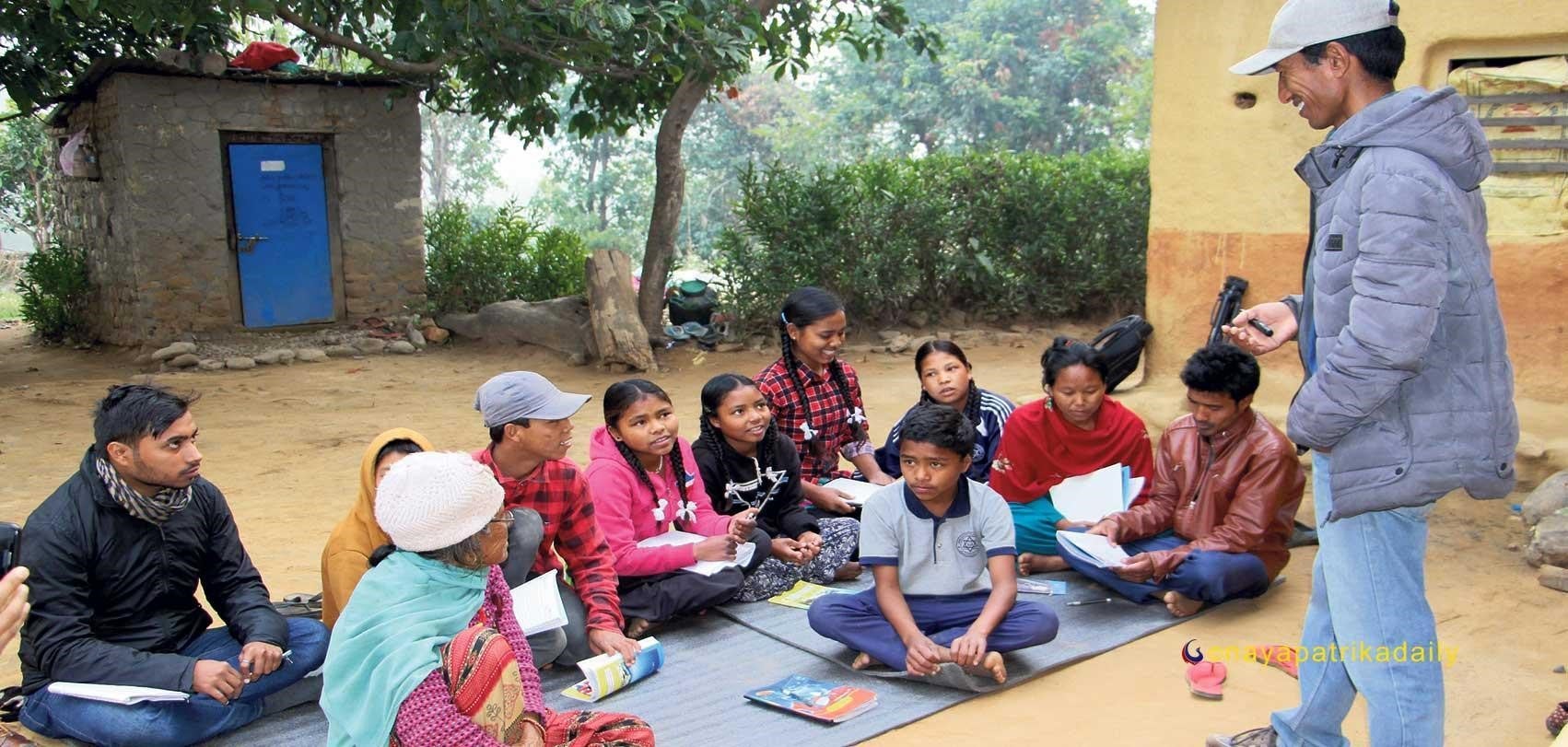
Photo: Kusunda children learning about the importance of their mother tongue from Uday Ale. Photo courtesy of Parinati.
The Nepali government is providing various vocational training for the Kusundas as well as a monthly social security allowance. The government has also built houses for many through the safe housing program. Other organizations have also been working in the area of Kusunda. Language classes are offered for Kusunda children under the supervision of researcher Ale, under the auspices of the National Language Commission for the Preservation of Kusunda Language and Language Transfer to the New Generation. The steps that need to be taken for the development and uplift of the Kusunda people are still many. Unless action is taken now, the Kusunda people, culture, and arts will be severely threatened and their language will go silent. If the Kusunda language goes silent, a unique and important part of our human heritage will be lost forever.
I want to draw the attention of national and international organizations and the people who are concerned about the issue of language revitalization. I am passionate about supporting them because they have been discriminated against and marginalized, and I want them to be supported and uplifted. The fellowship project was designed to make the Kusunda people aware about the uniqueness of their language. Many of their cultural practices are vanishing [along with their language]. I wanted to advocate for the rights of Kusunda people and to raise awareness of the need for their protection through this project. The project was more impactful than expected, and we got very appreciative responses from the Kusunda people. We believe that our radio programs will inspire people to do further studies and research. The Indigenous Community Youth Media Fellowship is one of the best opportunities to help Indigenous communities and for my personal development.
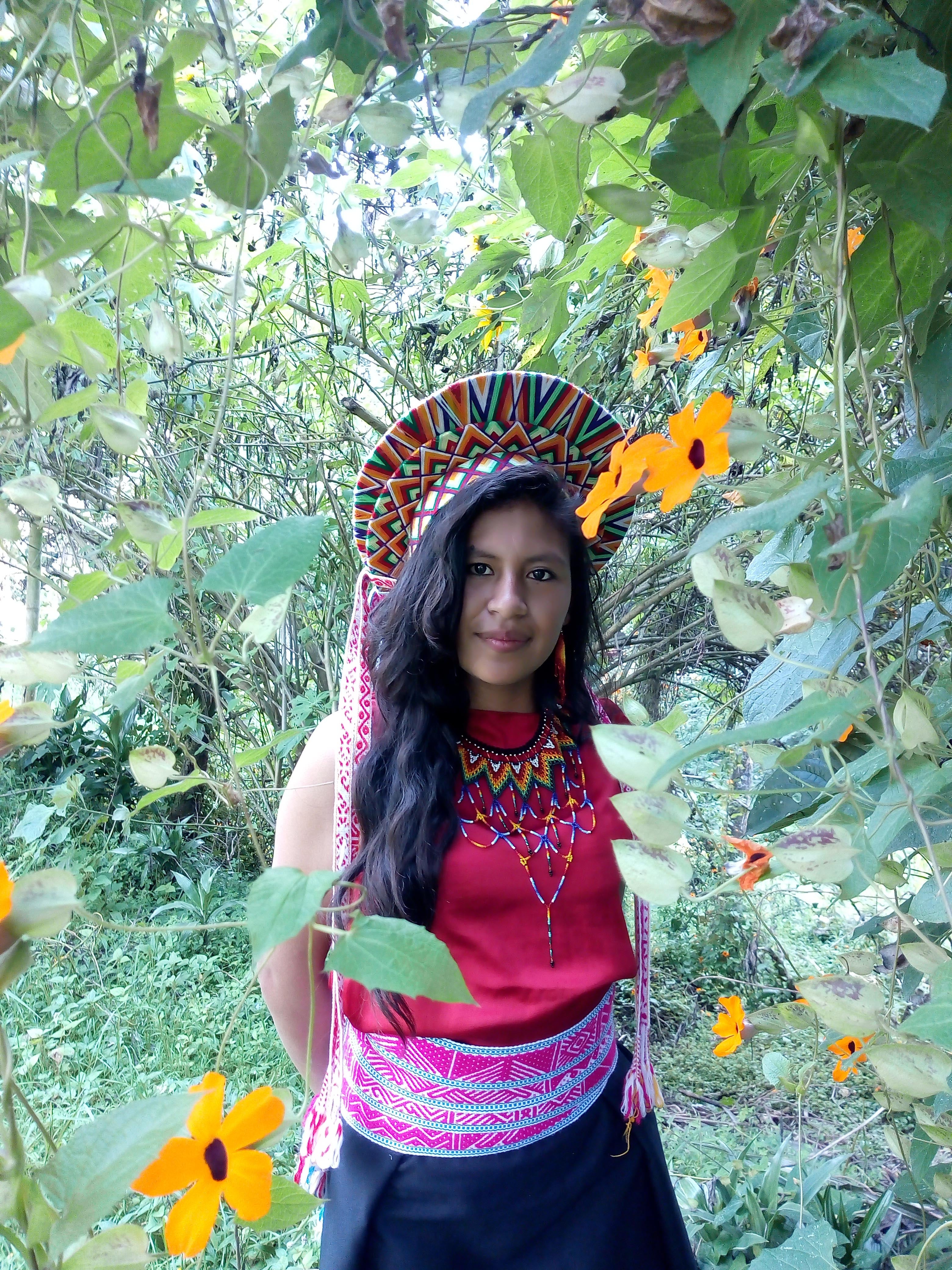
Photo: Lorena Jamioy Tisoy in traditional Inga-Kamëntsá clothing. Photo courtesy of Lorena Jamioy Tisoy.
Art Sustains the History of a Community
Lorena Jamioy Tisoy (Inga-Kamëntsá) is an Indigenous Community Media Youth Fellow from Valle de Sibundoy, Putumayo, Colombia. At 25, Tisoy is already a leader in her community. Her fellowship project, entitled, “Jajetsam Bëngbe Juabnac” (Weaving the Thought of Our Elders), uses radio programming and in-person workshops to facilitate the sharing of ancestral knowledge through weaving and storytelling. Tisoy says that the idea and the name of her project are rooted in the understanding that weaving is “the art that sustains the history of a community,” and that “it is important that this weaving is the thoughts of our elders.” The project’s ultimate goal is to strengthen community connections to the land and language.
As part of the Jajetsam Bëngbe Juabnac program, a series of workshops were held teaching youth how to make a variety of traditional crafts. One piece Tisoy focused on was the Tsombiache, a traditional faja (sash). She explains that the tsombiache “is an element that captures the totality of the oral tradition and that represents the life, history, and memory of the Kamёntsá community. The Tsombiache reflects the history of our ancestors through symbols, and in them is represented the histories of daily life, the environment, mother earth, the laborer, the rituals or sacred spaces and the celestial bodies.” Learning how to create the Tsombiache represented just one part of the process for workshop participants. During the program, children engaged with community elders who described the significance of the faja, along with its diverse symbols and colors.
Another workshop hosted by Tisoy focused on the Jabaichayam. The Jabaichayam is a fan made of palm that was traditionally used to intensify a fire. Tisoy explains that today the Jabaichayam is difficult to make due to the material’s scarcity: “It is already very difficult to access the primary materials like the cattail and the palm that are used to make those baskets and this fan. It’s that the plant is not easily sown and it is very challenging to access the seeds.”
Because of this, the Jabaichayam has been slowly falling out of use, and there are only a few elders who have knowledge of how to make the fans. A similar problem was encountered when Tisoy hosted a workshop teaching youth to weave the sbaruk, a traditional basket. Like the Jabaichayam, the sbaruk uses scarce plant materials, so it had to be produced on a smaller scale for the workshops. “These traditional elements are scarce in homes and they are only infrequently made. They are normally used as a form of weaving that represents artisanship and as such are not very common,” she says.
At the time of Tisoy’s project, new restrictions around community gatherings began to emerge because of the rapidly developing COVID-19 situation. Rather than become discouraged, Tisoy creatively adapted her workshops to ensure participant safety. She also proactively responded to the emerging challenges within her community by organizing a campaign called “Jajetsam cach Yebnentse Wassillapi Awaii” (Weaving at Home). She says, “Lessons and good practices were shared in the exchange of experiences and knowledge shared in each radio broadcast and in the workshops; [especially] the importance of self-care and caring for our elders in the face of COVID-19, and how we can help them to preserve the essence and knowledge [of our community] so that they are not lost in history, and the legacy will continue.”
The weaving project used the radio station Waishanya to bring attention to the difficulties being faced by artisans during the pandemic. Using radio, Tisoy was also able to provide artisans with a platform to share their knowledge while staying safe. Similar to the Jajetsam Bëngbe Juabnac program, Jajetsam cach Yebnentse Wassillapi Awaii focused on strengthening the cosmovision of the Kamëntsá and Inga communities of Sibundoy.
Tisoy says that the purpose of both programs is to engage community elders and youth in conversation. The hope is that through these connections, traditional knowledge can be strengthened and passed down. Regarding outcomes, Tisoy said that “we can see that the participation of small children and the youth surpassed what we had initially expected.” She also notes that one of the greatest difficulties was finding ways to accommodate the large interest. Going forward, Tisoy hopes to expand her program and be able to include more participants. She particularly wants to focus on engaging women and mothers acting as the head of household.
